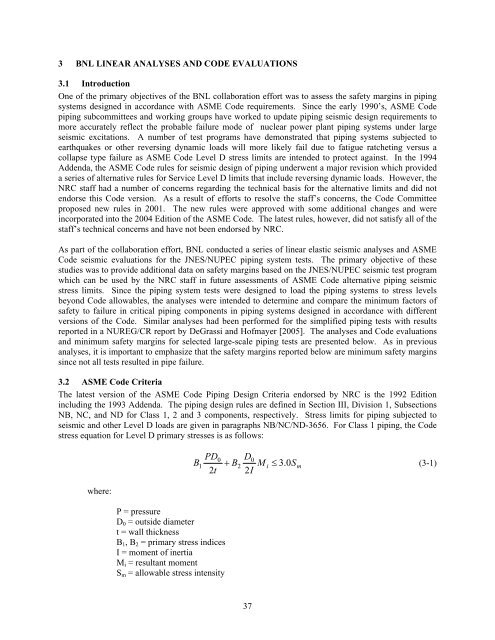Seismic Analysis of Large-Scale Piping Systems for the JNES ... - NRC
Seismic Analysis of Large-Scale Piping Systems for the JNES ... - NRC
Seismic Analysis of Large-Scale Piping Systems for the JNES ... - NRC
Create successful ePaper yourself
Turn your PDF publications into a flip-book with our unique Google optimized e-Paper software.
3 BNL LINEAR ANALYSES AND CODE EVALUATIONS<br />
3.1 Introduction<br />
One <strong>of</strong> <strong>the</strong> primary objectives <strong>of</strong> <strong>the</strong> BNL collaboration ef<strong>for</strong>t was to assess <strong>the</strong> safety margins in piping<br />
systems designed in accordance with ASME Code requirements. Since <strong>the</strong> early 1990’s, ASME Code<br />
piping subcommittees and working groups have worked to update piping seismic design requirements to<br />
more accurately reflect <strong>the</strong> probable failure mode <strong>of</strong> nuclear power plant piping systems under large<br />
seismic excitations. A number <strong>of</strong> test programs have demonstrated that piping systems subjected to<br />
earthquakes or o<strong>the</strong>r reversing dynamic loads will more likely fail due to fatigue ratcheting versus a<br />
collapse type failure as ASME Code Level D stress limits are intended to protect against. In <strong>the</strong> 1994<br />
Addenda, <strong>the</strong> ASME Code rules <strong>for</strong> seismic design <strong>of</strong> piping underwent a major revision which provided<br />
a series <strong>of</strong> alternative rules <strong>for</strong> Service Level D limits that include reversing dynamic loads. However, <strong>the</strong><br />
<strong>NRC</strong> staff had a number <strong>of</strong> concerns regarding <strong>the</strong> technical basis <strong>for</strong> <strong>the</strong> alternative limits and did not<br />
endorse this Code version. As a result <strong>of</strong> ef<strong>for</strong>ts to resolve <strong>the</strong> staff’s concerns, <strong>the</strong> Code Committee<br />
proposed new rules in 2001. The new rules were approved with some additional changes and were<br />
incorporated into <strong>the</strong> 2004 Edition <strong>of</strong> <strong>the</strong> ASME Code. The latest rules, however, did not satisfy all <strong>of</strong> <strong>the</strong><br />
staff’s technical concerns and have not been endorsed by <strong>NRC</strong>.<br />
As part <strong>of</strong> <strong>the</strong> collaboration ef<strong>for</strong>t, BNL conducted a series <strong>of</strong> linear elastic seismic analyses and ASME<br />
Code seismic evaluations <strong>for</strong> <strong>the</strong> <strong>JNES</strong>/NUPEC piping system tests. The primary objective <strong>of</strong> <strong>the</strong>se<br />
studies was to provide additional data on safety margins based on <strong>the</strong> <strong>JNES</strong>/NUPEC seismic test program<br />
which can be used by <strong>the</strong> <strong>NRC</strong> staff in future assessments <strong>of</strong> ASME Code alternative piping seismic<br />
stress limits. Since <strong>the</strong> piping system tests were designed to load <strong>the</strong> piping systems to stress levels<br />
beyond Code allowables, <strong>the</strong> analyses were intended to determine and compare <strong>the</strong> minimum factors <strong>of</strong><br />
safety to failure in critical piping components in piping systems designed in accordance with different<br />
versions <strong>of</strong> <strong>the</strong> Code. Similar analyses had been per<strong>for</strong>med <strong>for</strong> <strong>the</strong> simplified piping tests with results<br />
reported in a NUREG/CR report by DeGrassi and H<strong>of</strong>mayer [2005]. The analyses and Code evaluations<br />
and minimum safety margins <strong>for</strong> selected large-scale piping tests are presented below. As in previous<br />
analyses, it is important to emphasize that <strong>the</strong> safety margins reported below are minimum safety margins<br />
since not all tests resulted in pipe failure.<br />
3.2 ASME Code Criteria<br />
The latest version <strong>of</strong> <strong>the</strong> ASME Code <strong>Piping</strong> Design Criteria endorsed by <strong>NRC</strong> is <strong>the</strong> 1992 Edition<br />
including <strong>the</strong> 1993 Addenda. The piping design rules are defined in Section III, Division 1, Subsections<br />
NB, NC, and ND <strong>for</strong> Class 1, 2 and 3 components, respectively. Stress limits <strong>for</strong> piping subjected to<br />
seismic and o<strong>the</strong>r Level D loads are given in paragraphs NB/NC/ND-3656. For Class 1 piping, <strong>the</strong> Code<br />
stress equation <strong>for</strong> Level D primary stresses is as follows:<br />
where:<br />
P = pressure<br />
D0 = outside diameter<br />
t = wall thickness<br />
B1, B2 = primary stress indices<br />
I = moment <strong>of</strong> inertia<br />
Mi = resultant moment<br />
Sm = allowable stress intensity<br />
PD0<br />
D0<br />
B1 + B2<br />
M i ≤ 3.<br />
0Sm<br />
(3-1)<br />
2t<br />
2I<br />
37
















